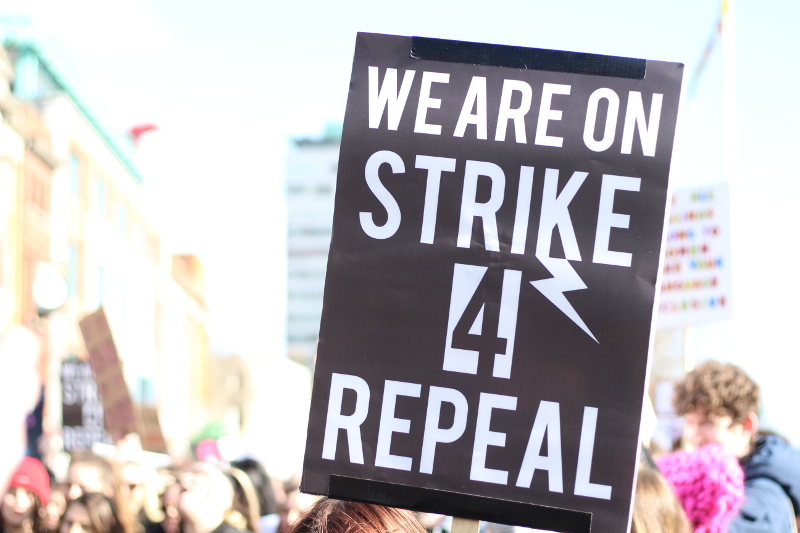Members of Strike 4 Repeal – which gathered thousands of students onto the streets in March – planned the campaign’s next steps this evening, as they looked towards a referendum on the eighth amendment.
While turnout was small, many in the room were optimistic. Yesterday, the Oireachtas Committee on the Eighth Amendment voted to recommend the repeal of the eighth amendment, as well as a host of liberal reforms to Ireland’s restrictive abortion law.
Following the recommendations from the committee, the next step is to establish a wording for the referendum, as well as a date. Yesterday, Taoiseach Leo Varadkar indicated that he would prefer a May date for a referendum on the eighth amendment, easing student concerns over the impact of a summer referendum.
Strike 4 Repeal is calling for free, safe and legal abortion as well as asking the government to commit to a clear “yes” or “no” question on whether the eighth amendment should be repealed.
The strike last March saw thousands of people, including a 600-strong contingent from Trinity, block access to O’Connell Bridge. This time around, organisers want to make the reach of the strike stretch further. Suggestions ranged from occupying all the bridges along the Liffey – which would stop people crossing the city – to taking up residence on the recently completed Luas tracks in city centre.
One of the main concerns of the night was the potential for complacency, after the recent successes at the Oireachtas committee, as well as the high turnout at the March for Choice in September.
With a date for a strike still not agreed, discussions revolved around having it sometime between January 16th and mid-February. If the government hasn’t agreed on a wording by the latter date, it’s more likely a referendum will take place in June. Student groups such as Trinity’s Strike 4 Repeal and the Union of Students in Ireland (USI) are keen to have a May referendum to ensure that students, one of the most vocal groups in the debate, will have the opportunity to vote.
Students also voiced concerns about an early election, if the government collapses, and the impact it might have on the timeline of a referendum. Everyone who attended the meeting was in their final year of college and there were concerns that should the referendum be delayed, there wouldn’t be a contingent of younger students to continue the push from within Trinity for abortion rights.
Trinity College Dublin Students’ Union (TCDSU) President Kevin Keane pointed out that they had “struggled massively” to engage students in Trinity Hall ahead of previous marches. Engaging this cohort of younger students was seen as a key aim going forward. Sadhbh Sheeran, one of the group’s organisers, commented on how students in Trinity Hall have had a “very wholesome” experience of the repeal campaign and that they had to ensure they didn’t appear forceful and isolating. One of the main ideas discussed was holding an event where students could listen to how people became involved in the campaign, while also giving them the opportunity to talk to organisers and become involved themselves. Other ideas raised were asking students to stick strike posters in their windows and going door to door to talk students through their stance.
Last year, the group successfully used guerilla tactics to boost the profile of the campaign, painting lightning bolts across campus and covering statues in black. Acknowledging that tactics like this get student support and raise awareness of their cause, the group discussed other ways that they could grab people’s attention. Ideas discussed tonight included photoshopping repeal jumpers on statues and painting lighting strikes around campus. Social media campaigns were also discussed. Another photo campaign, similar to the “We Won’t Wait” campaign the group ran last time, was suggested.
Yesterday, members of Strike 4 Repeal heavily criticised student media in Trinity for failing to cover the campaign, after it brought a discussion item to TCDSU’s council on Tuesday. In February, TCDSU voted to support the Strike 4 Repeal movement.
Members of the group also claimed on social media that Irish media didn’t cover the strike. RTÉ was criticised by pro-choice activists for its lack of coverage of the strike – which shut down central Dublin for hours .
In March, The University Times and Trinity News had several articles on the strike. On the day of the strike, two members of the campaign covered the statues of George Salmon and William Lecky in black to mark the day. Thousands of students took part in the strike, before joining a march for choice that evening.
Writing in The University Times ahead of the strike, Áine Palmer, one of the organisers of the Trinity branch of Strike 4 Repeal, wrote: “We are a generation who have not even had the chance to vote on this issue. We need to take the opportunity to let our voices be heard.”
Over the last few months, thousands of young people on both sides of the border took to the streets of Belfast and Dublin to call for access to abortion.







